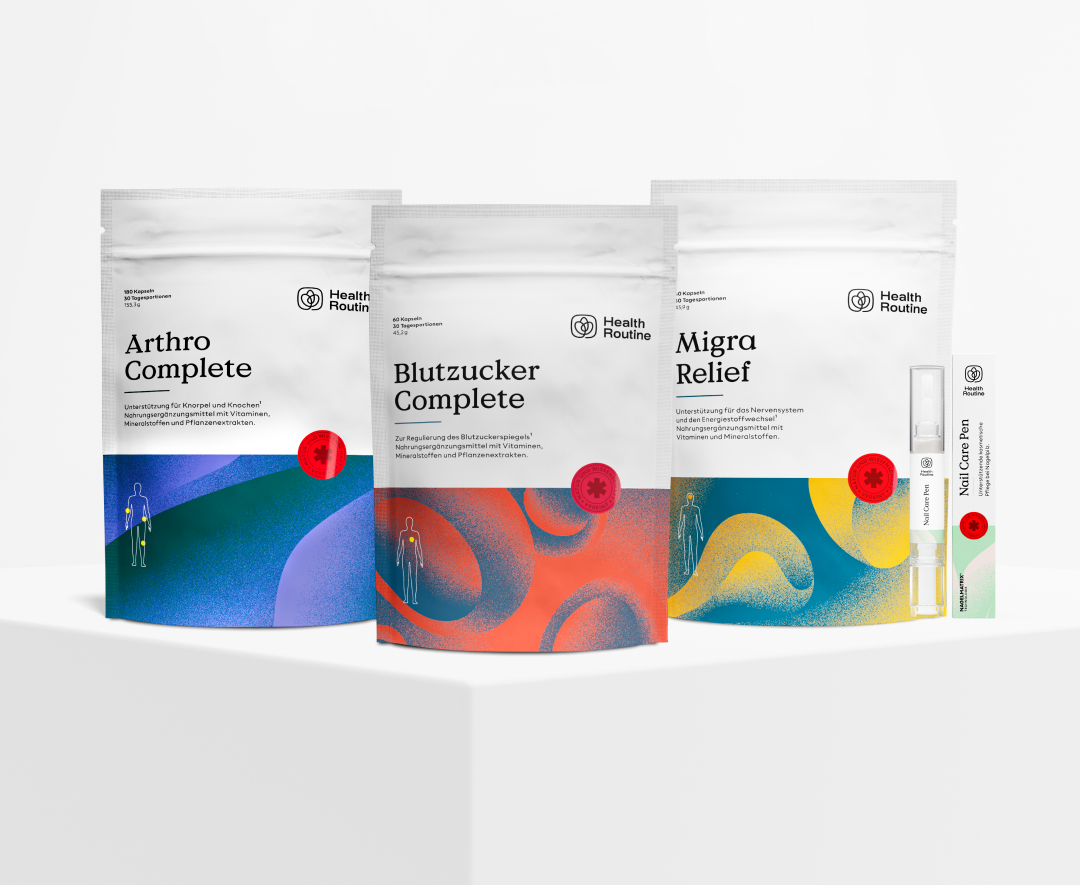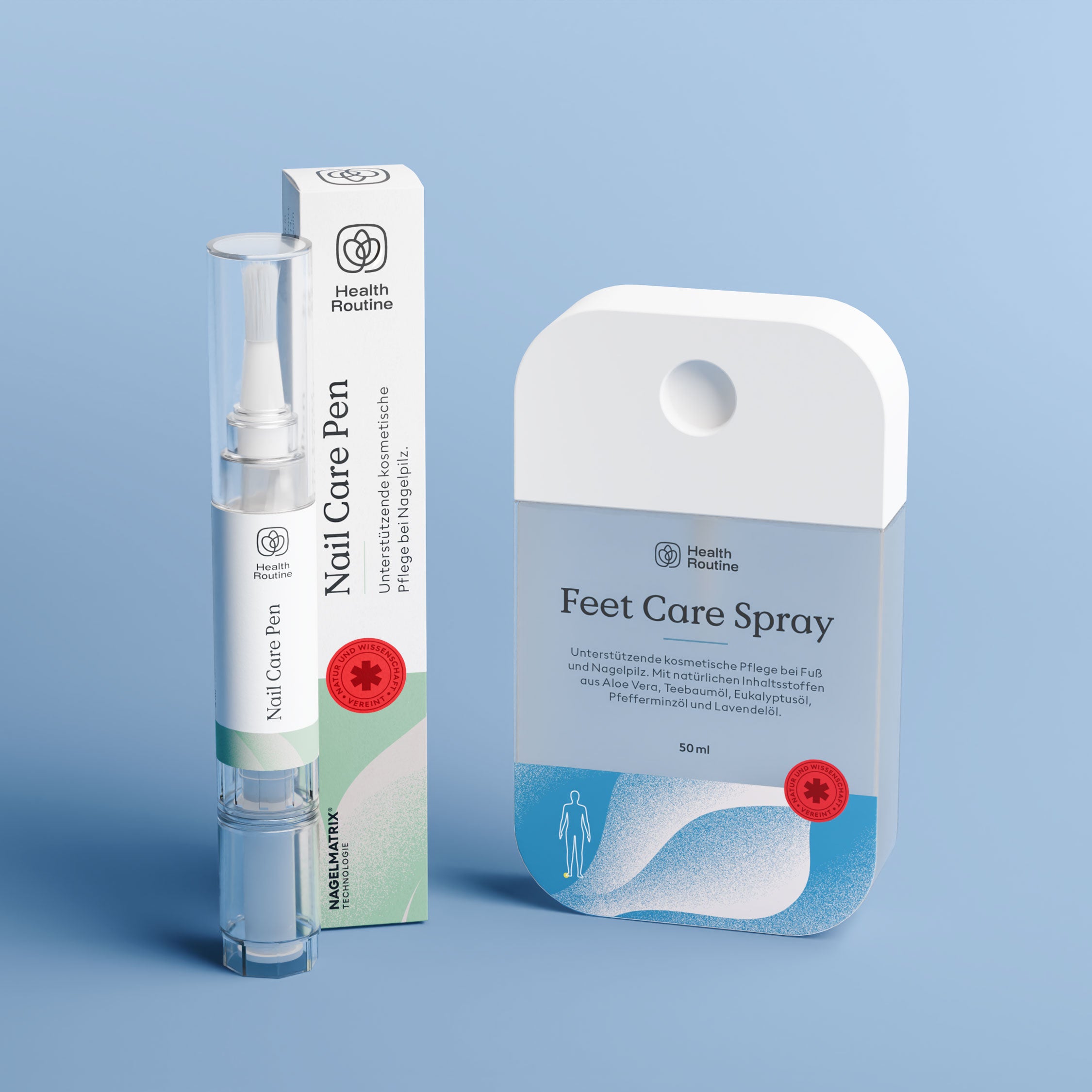The most important things at a glance:
- Nail fungus can affect both toenails and fingernails and is caused by various types of fungi.
- Common triggers are moisture, tight shoes and a reduced immune function of the skin.
- Fungi such as dermatophytes, yeasts or molds prefer to settle in a warm and humid environment.
- Various products are available for targeted nail care – such as the HealthRoutine Myko-Matrix nail fungus solution .

Verzorgt ook cosmetisch bij nagelschimmelinfectie
Hydrateert & regenereert
Beschermt & versterkt de nagels
What is nail fungus and how does it arise?
Nail fungus – medically known as onychomycosis – is an infection of the nails that is primarily caused by filamentous fungi (dermatophytes), less commonly by yeasts or molds. Toenails are most commonly affected, but fingernails can also show changes.
Typical conditions are humid and warm , such as those found in closed shoes or communal facilities.
Typical starting situations:
-
First signs: Discoloration or changes usually occur at the free edge of the nail.
- Nail fungus cause: A combination of fungi and humid climate – for example through sweating or walking barefoot in swimming pools.
Which types of fungi play a role?
|
Mushroom species |
Description |
|
Dermatophytes |
The most common pathogens, including Trichophyton rubrum , prefer horn material. |
|
Yeast fungi |
E.g. Candida albicans , often involved in fingernails. |
|
mold |
Usually only occurs in previously damaged nails. |
Depending on the condition of your nails, a tailored care routine may be beneficial . Nail care products from HealthRoutine can be specifically integrated into your daily routine— complemented by the new Myko-Matrix solution for targeted treatment of fungal infections.
Sets for nail fungus from Health Routine:
Common triggers – these factors can play a role:
|
Risk factor |
Description |
|
Weakened defenses |
The skin is less resistant to external influences. |
|
diabetes |
Changes in the skin can increase susceptibility. |
|
Circulatory disorders |
Nails receive fewer nutrients – which makes them more vulnerable. |
|
Tight shoes |
Heat and humidity build up – an ideal environment for fungi. |
|
Wet feet |
Wearing damp socks or shoes for a long time promotes fungal growth. |
|
Public areas |
Swimming pools, changing rooms or saunas can be contaminated with fungal spores. |
|
Older age |
As we age, the structure of our nails changes. |
|
Familial clustering |
Some people are naturally more vulnerable. |
Particularly relevant: tight shoes and wet feet
Closed shoes without breathability trap moisture—an environment that promotes fungal growth. Make sure you wear well-ventilated footwear and regularly care for your feet.
Public places as a cause of nail fungus
Many people move barefoot in areas like swimming pools or saunas . Fungal spores can easily be transmitted there. Wear bathing shoes and make sure you dry yourself thoroughly after showering.
Signs of nail fungus – what you should look out for:
- Nail discoloration : Yellowish, brownish or whitish changes on the nail
- Thickening & deformation : The nail becomes thicker, wavy or irregular
- Brittle toenails : Nails split or break more easily
- Nail detachment : In advanced cases, the nail may partially detach from the nail bed
- Itching & pressure sensation : Especially possible around the affected tissue
|
symptom |
Description |
|
Discoloration |
Whitish, yellowish to dark brown |
|
thickening |
Nail becomes thicker or grows irregularly |
|
brittleness |
Nails tear or break more quickly |
|
replacement |
Nail comes off partially or completely |
|
itching |
Discomfort on the surrounding skin |
What helps with nail changes caused by fungi?
Care options:
- Nail polish & solutions : For external use, especially in mild cases
- Capsules/tablets : In consultation with the doctor – e.g. in case of severe infestation
- Combined care : Using multiple approaches simultaneously
- Removal of severely altered nails : Only necessary in severe cases
The Myco-Matrix solution from Health Routine
For the targeted treatment of nail fungus – with the active ingredient ISK1320 to inhibit fungal growth and Natilact, which lowers the pH of the nail environment. In vitro tests prove the antifungal effect.
Application :
- Apply Myko-Matrix nail fungus solution 1-2 times daily after filing.
- After absorption, care for the nail with the HealthRoutine Nail Care Pen – for regeneration and strengthening of the nail structure.

Verzorgt ook cosmetisch bij nagelschimmelinfectie
Hydrateert & regenereert
Beschermt & versterkt de nagels
Tips for everyday life
Regular foot and nail care can help reduce the risk of visible changes.
Here are a few simple measures:
- Wash feet regularly and dry them thoroughly
- Choose breathable socks and shoes
- Changing shoes and socks after sporting activity
- Wear bathing shoes in public areas
- Check nails regularly
Conclusion
Fungal nail infections are widespread, but can be easily controlled with targeted attention. Knowing the typical triggers and paying attention to regular care can help keep nails in good condition. Particularly helpful: the combination of Myco-Matrix treatment and the Nail Care Pen from Health Routine – for well-groomed nails, day after day.
FAQ
How do I recognize nail fungus?
Typical symptoms include discolored, thickened, and brittle nails that can detach from the nail bed.
What can I do if my nail changes?
In addition to medical advice, the use of Myko-Matrix & Nail Care Pen is recommended for daily support.
How can I reduce my risk?
Good hygiene, breathable footwear and targeted care products are key.
Is nail fungus contagious?
Yes – through direct skin contact or contaminated surfaces such as floors in public areas.
What are common causes?
Humidity, heat, tight shoes, weak immune system and lack of care.






